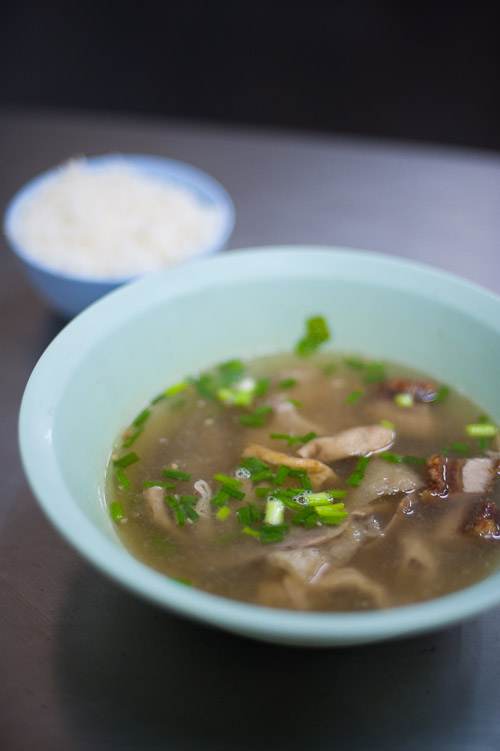 Over the last few months, I've done several articles for CNNGo's Bangkok pages on Thai dishes that resident foreigners (and sometime even resident natives) may not familiar with, and a few recommended places to sample them. So far I've covered kaeng karii, khao khluk kapi, khanom jeen nam ngiaw, kuytiaw luy suan and kuaytiaw khua kai. At the moment I'm at work on one about kuay jap nam sai, the Chinese/Thai dish that combines pork offal and a peppery broth. Of the six or so restaurants and stalls I've investigated for the piece, my favourite was probably Mister Jo.
Over the last few months, I've done several articles for CNNGo's Bangkok pages on Thai dishes that resident foreigners (and sometime even resident natives) may not familiar with, and a few recommended places to sample them. So far I've covered kaeng karii, khao khluk kapi, khanom jeen nam ngiaw, kuytiaw luy suan and kuaytiaw khua kai. At the moment I'm at work on one about kuay jap nam sai, the Chinese/Thai dish that combines pork offal and a peppery broth. Of the six or so restaurants and stalls I've investigated for the piece, my favourite was probably Mister Jo.
Kuay jap is based around pork offal (heart, tongue, intestines, liver, spleen), but the crispy pork belly is what can make or break a restaurant. Mister Jo's pork belly is so good that it's also available separately, served on plates with a soy sauce dipping sauce. The broth is peppery -- as a good kuay jap broth should be -- but not assertively so, and was probably the most balanced of the various places I visited. Unusually, it includes squares of tender pork skin. And unlike most places serving kuay jap, Mister Jo is open during the day. As a result, it's crazy popular, and you'll almost certainly have to navigate a lengthy queue of to-go orders simply to step foot inside the restaurant.
Stay tuned to CNNGo Bangkok's Eat page to see the entire list of kuay jap nam sai stalls and restaurants I found.
Mister Jo 313/7 Th Chan, Bangkok 8.30am-4pm
View Thai Eats in a larger map


























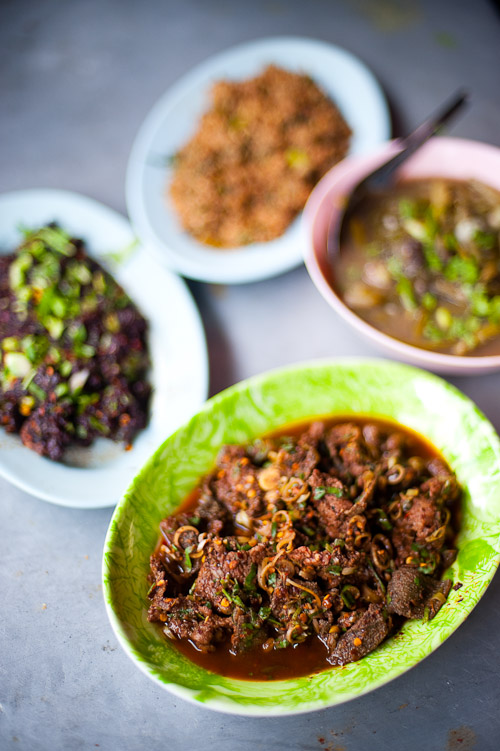






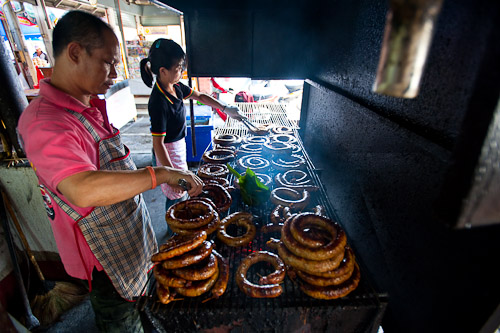









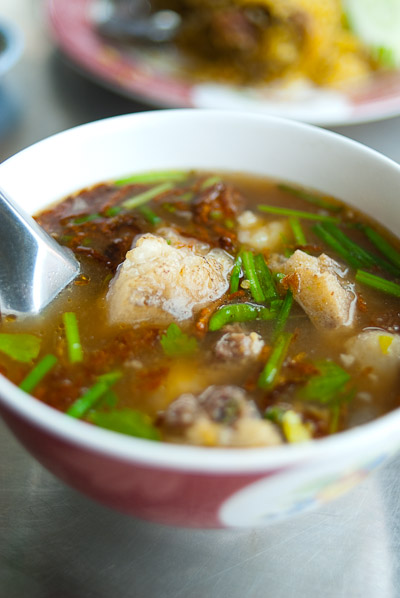







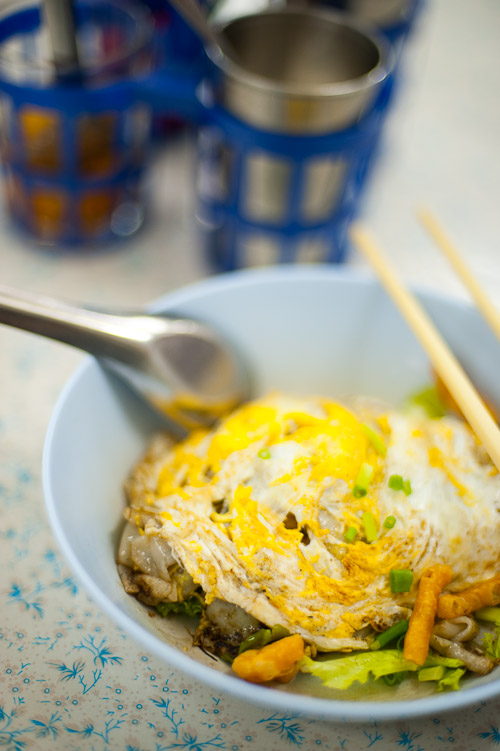
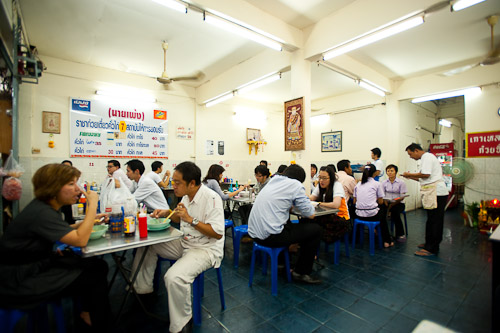
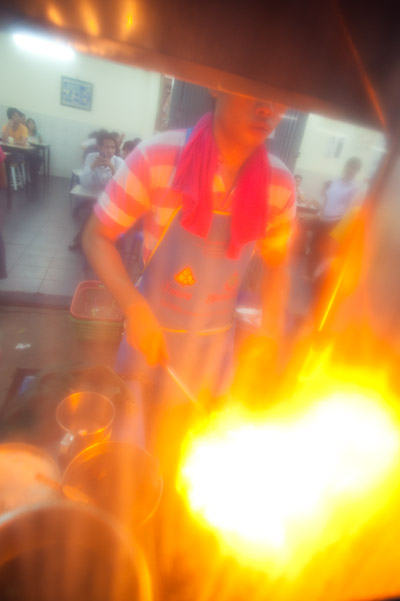



 First of all, allow me to apologise for not having blogged for such a long time. I had back surgery in early July and since then have been recovering, admittedly with enough time to blog, but unfortunately little in the way of content or desire. I’m more or less mobile now and am ready to jump...er carefully lower myself back into blogging again.
First of all, allow me to apologise for not having blogged for such a long time. I had back surgery in early July and since then have been recovering, admittedly with enough time to blog, but unfortunately little in the way of content or desire. I’m more or less mobile now and am ready to jump...er carefully lower myself back into blogging again.



 Sawang is a decades-old bamee (wheat and egg noodles) joint virtually across the street from Bangkok's Hualamphong Train Station. It's easily located by its overabundance of florescent green lighting and the aged and rather grumpy owner who sits in a chair out front. Some aged promotional material inside desribes Sawang as "The most expensive bamee in Thailand." Yet despite these ominous attributes, it's now my favourite place in town to eat the dish.
Sawang is a decades-old bamee (wheat and egg noodles) joint virtually across the street from Bangkok's Hualamphong Train Station. It's easily located by its overabundance of florescent green lighting and the aged and rather grumpy owner who sits in a chair out front. Some aged promotional material inside desribes Sawang as "The most expensive bamee in Thailand." Yet despite these ominous attributes, it's now my favourite place in town to eat the dish.


 Jay So originally comes from Yasothon, if I remember correctly, and opened her eponymous northeastern Thai restaurant in Bangkok's Silom area more than a decade ago. She's cheeky and boisterous, and eating at her place, with the smell of plaa raa (fermented fish) and the sound of the northeastern Thai dialect being spoken, is probably not unlike eating at restaurant in her home province. I've been eating here for years, and despite not having been back in a long while, she still somehow remembered that I like my som tam without sugar.
Jay So originally comes from Yasothon, if I remember correctly, and opened her eponymous northeastern Thai restaurant in Bangkok's Silom area more than a decade ago. She's cheeky and boisterous, and eating at her place, with the smell of plaa raa (fermented fish) and the sound of the northeastern Thai dialect being spoken, is probably not unlike eating at restaurant in her home province. I've been eating here for years, and despite not having been back in a long while, she still somehow remembered that I like my som tam without sugar.



